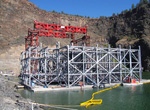Hot-Dip Galvanized Steel in Water Applications
The varieties of water throughout the world differ to the extent that predicting corrosion rates is very difficult for all coatings. Many parameters affect corrosion of metals in a water environment , including pH level, oxygen content, water temperature, water climate and tide conditions, to name a few. Despite the difficulty of predicting corrosion, it is important to note that galvanized coatings on steel used in submersed applications is still one of the best methods of corrosion protection. It is common for hot-dip galvanized steel to perform flawlessly in harsh water environments such as seawater for eight to 12 years.

The first step in deciding whether galvanized steel is the right coating for your application is to determine what type of water will be used. Water can be divided into a number of different types; pure water (e.g., distilled water or de-ionized water), natural fresh water, potable water (treated drinking water), or seawater. Hard water and soft water also cause corrosion to different degrees, as do hot and cold water. The applications utilizing hot-dip galvanized steel range from boat docks and piers to pilings and dam trash gates.
© 2025 American Galvanizers Association. The material provided herein has been developed to provide accurate and authoritative information about after-fabrication hot-dip galvanized steel. This material provides general information only and is not intended as a substitute for competent professional examination and verification as to suitability and applicability. The information provided herein is not intended as a representation or warranty on the part of the AGA. Anyone making use of this information assumes all liability arising from such use.

